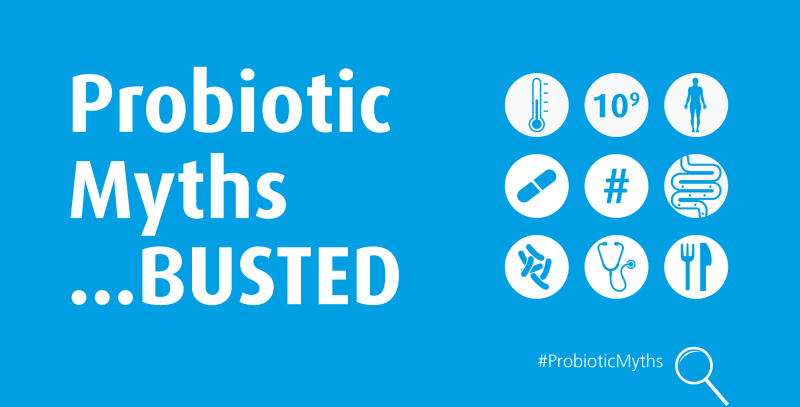Myths

Myth #1 –Yogurt and Kefir are effective probiotics.
THEY ARE GOOD FOODS. Yogurt and Kefir are considered ‘functional fermented foods’ and while they may contain ‘live and active cultures’ it is usually in very low doses, too low to have any therapeutic effect. In addition, they are often pasteurised (which kills probiotics) and lack any protective delivery system to help them survive transit through our harsh acidic stomach to reach the small and large intestine where they are most active.
Also, most yogurts and kefir are filled with sugar, preservatives and all kinds of things that aren’t good for you. To give you an example, an average 150gm serving of yogurt contains 22 grams of sugar and 157 calories, with some yogurts as high 36 grams of sugar and 260 calories per serving! To get the same quantity of probiotic bacteria found in one convenient probiotic capsule (30 billion cfu) you would have to consume 27 servings of yogurt; that’s 4,239+ calories and 594 grams of sugar!
We’re not saying, don’t eat a properly made yogurt or throw away your sauerkraut, we enjoy these too and believe they are really great additions to a healthy diet (Natren’s founder even played a role in setting the liquid yogurt standards), but realise that the amount of probiotic received is minimal and not likely to have a major impact on your overall gut health.
Myth #2 – Very High Potency Probiotics offer better results than lower potency probiotics.
Not Always. The numbers of colony forming units (cfus) are important to be familiar with and should be clearly stated on the label for every strain included in the probiotic, however, a higher number does not always indicate a better product. Experts have agreed on a minimal number of viable cells at 1 billion cfus per day. This provides a great starting point/minimum dose but what’s next? Well, it is not always an easy question to answer for one reason – you also need to know how PROTECTED those probiotics are and how well they will SURVIVE through transit, storage and shelf life.
Many probiotics offer little to no protection to assist them as they move through the digestive tract ultimately reaching our small and large intestine where they are most active, but getting them unharmed to this location poses a problem – how to get them through our highly acidic stomachs alive? In addition, the stress on living organisms through shipping and shelf life can lead to very small numbers of live organisms by the time they reach the consumer. The bottom line is if you are confident in your delivery system through the stomach and you know your product maintains potency through the expiration date, you may not need these very high cfu counts. Perhaps more important than falling for this numbers game is to look into the quality and the number of identified strains present and how they are being protected/delivered to the active site in your GI tract… which leads me to myths three, four and five….
Myth #3 – Multi-strain probiotics are better than targeted single strain probiotics.
Now, this is a tough one, because multi-strain probiotics that are manufactured so that each strain is separated, identified and validated are an excellent choice. This means that if there is more than one bacteria inside the capsule or powder they are not in contact with each other. Not all multi-strain probiotics are not made this way. By their very nature all bacteria are antagonistic – meaning they don’t play well together. In fact, one of the reasons probiotics are effective is because they displace potentially harmful bacteria in our gut with beneficial bacteria. Now, think about that statement… they work by displacing one another.
This is what we call a closed – ended system” problem – when you place a live product into a closed-ended system such as a capsule/bottle you limit available resources (ie. oxygen, food) and the bacteria fight to use up the resources until they are depleted, once the resources are gone the bacteria begin to die. We can prevent some of this through freeze drying, which arrests bacterial growth, but since we are trying to maintain a live organism some competition will continue.
The reality is a HUGE segment of probiotics on the market today are contract manufactured by one company with a marketing position. Look for companies that genuinely care about your health, companies that continue to research and explore the science of probiotics on a regular basis and companies who are the actual manufacture of their product.
Myth #4 – All probiotic species and strains are the same.
FALSE. That’s like saying you and I are one and the same. We are both homo sapiens, sapiens after all, so we can’t be that different, right? Wrong.
Take for example the most commonly referred to probiotic Lactobacillus acidophilus, Lactobacillus identifies the probiotic at the genus level. Add on acidophilus and you have now identified the species level. But what comes next? This is where common names come in. It’s the same with probiotics but instead of a common name we have STRAIN names. For example, Natren uses Lactobacillus acidophilus, NAS strain. And just like you and I are different, every strain of L. acidophilus is different. Many manufacturing companies do not distinguish the strains; they wrongfully assume that all L. acidophilus strains are the same. In fact, each strain can have varying probiotic benefits and strengths. For example, not all L. acidophilus strains adhere well in the GI tract, without this important characteristic they tend to wash right through our bodies, in one end and out the other. Look for a quality product that identifies genus (ex. Lactobacillus), species (ex. acidophilus) and strain (ex. NAS); all together it looks like this: Lactobacillus acidophilus, NAS.
Myth #5 – Enteric coatings provide sufficient protection for probiotics.
FALSE. The difficult part about working with these delicate living organisms is delivering them safely to the part of our GI tract where they naturally exist, the small and large intestine. That stomach gets in the way every time, the low acidity in the stomach was designed to keep bacteria out! So protection, to help bacteria survive through the stomach, is important, but enteric coatings are the wrong way to go for one main reason – they retain moisture! All probiotics are freeze-dried (unless the product is fresh as in yogurt); freeze drying temporarily arrests the growth of the bacteria and eliminates moisture. So what reactivates their growth? You guessed it, moisture! If the enteric coating process adds moisture back into the product the bacteria begin to grow and compete with one another for resources, eventually they run out of resources within the capsule or bottle and die quickly.
So how can you properly protect probiotics? The answer actually has numerous parts; you start by selecting well-studied strains (see Myth #4) that are known to be hardy, coupled with a manufacturing process that includes the supernatant. During the manufacturing process bacteria are grown on a specialised food or growth medium, after fermentation occurs this is referred to as the supernatant or fermentation end product. There are valuable by-products within the supernatant. Probiotics that go through a full culture process to maintain this intrinsic supernatant in the final product are adding an additional layer of protection to the product as it naturally shields the bacteria from stomach acid. The supernatant is so valuable, as it adds additional benefits to the probiotic user in the form of micronutrients. So keep the supernatant with the bacteria’s!
And finally, you have protective packaging: look for supplements that are further protected by dark glass bottles or boxes. The dark bottles are resistant to UV damage and the glass is impermeable to moisture compared to plastic. Whereas, plastic is highly permeable so not a desirable packaging for bacteria’s, and it’s not as eco-friendly as glass.
Myth #6 – Homeostatic soil organisms and spore-forming bacteria are safe and effective probiotics.
FALSE. The whole point of probiotic supplementation is to help restore the balance in your digestive system. How do we do this? By supplying the GI tract with probiotic bacterial species that normally colonise the human GI tract. How can you expect to balance this system by ingesting bacteria that are not normally found here? Some companies use soil borne bacteria such as the genus Bacillus in probiotic products because they are stable since they produce spores. Spores can survive extremes such as heating, freezing, drying and radiation. Also, if a spore is an inactive vegetative state of bacteria how do we know if it ever becomes active inside our body?
Myth #7 – You shouldn’t take probiotics when you are taking prescription antibiotics.
FALSE. It is even more important to take probiotics while you are taking antibiotics. Antibiotics are very potent, and cause a dramatic change to your microbiome because they kill not only the bad bacteria in your body that are causing an infection, but kill the good bacteria as well. This may be why antibiotics are often associated with nasty gastrointestinal symptoms such as diarrhoea. In fact, taking probiotics has been shown to reduce the incidence of antibiotic associated diarrhoea by 42%!
In order to allow both antibiotics and probiotics to work in your GI tract simply separate the times that you take them by at least a few hours. Take your antibiotics, then 2 hours later take your probiotics.
Myth #8 – You do NOT need to take a probiotic everyday.
Probiotics can only benefit you if you take them. You might think that if you aren’t actively doing something to damage your gut microbiota, such as taking antibiotics, that you don’t need a probiotic supplement. This is wrong. There are many reasons why you may have an unbalanced and unhealthy gut microbiota. For example, an unvaried, highly refined diet and stress can lead to an off-balance system. Speaking of diet, every time you eat you are introducing bacteria into your GI tract that may or may not be harmful, balancing this with beneficial probiotic bacteria is always a good idea. In addition, excessive hygiene precautions and chlorinated drinking water; many drinking water sources contain anti-microbial agents such as chlorine that kill the good bacteria in our bodies. By supplementing with a high quality probiotic you can off-set these problems and set your body on the right path to health every day.
Myth #9 – Diet does not play a role in probiotic effectiveness.
FALSE. Diet is just as important to bacteria as it is to humans. Studies have shown that the composition of our gut microbiota changes in response to the diet we eat. An unbalanced, unvaried, highly refined diet contributes to a less diverse makeup of bacteria in our gut. Scientists hypothesise that decreased microbial exposure through diet and other means are the cause of numerous health problems today. It is important to enjoy a varied diet to benefit your health as well as the health of your bacteria. Exercise helps too.

